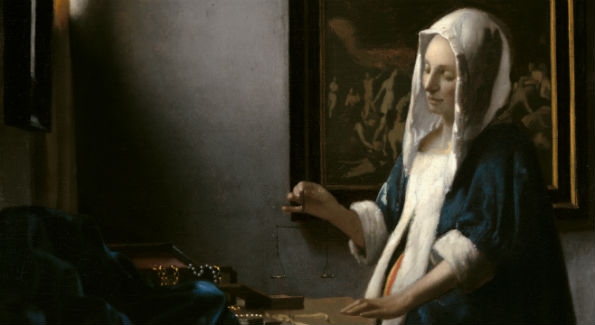By: Roland Flamini

Johannes Vermeer, Woman Holding a Balance, c. 1664. A woman holds a balance seemingly intending to weigh gold and jewelry spilling out of the box onto the table. National Gallery of Art, Washington, Widener Collection.
In the National Gallery of Art’s great Johannes Vermeer exhibition of 1995, the Dutch painter was portrayed as a solitary genius, the “Sphinx of Delft,” as he had been called by Théophile Thoré-Bürger, the 19th century French art critic who re-discovered him after 300 years of obscurity. This October, Vermeer is back at the National Gallery, and he has brought along his friends – or, more precisely, some of his contemporary rivals.
“Vermeer and the Masters of Genre Painting: Inspiration and Rivalry” sets out to refute the misconception that Vermeer worked in isolation by placing him at the center of the flourishing network of so-called genre painters working in different cities in what is now the Netherlands, but sharing similarities of inspiration, subject matter, composition and technique.
Dutch genre painting of the 17th century is a narrative of the everyday pursuits of the leisure class, when Holland – newly liberated from Spanish domination – was the leading economic and colonial power in Europe.
The result is a series of paintings Adriaan Waiboer, curator at the National Gallery of Ireland who first conceived the idea of the exhibition, calls “high life imagery” in which men and women are shown writing letters, playing musical instruments, in social settings and even holding exotic pet parrots. The exhibition offers variations on several of these themes in one brilliant painting after another, the work of an artists’ collective that included Vermeer, Gerard ter Borch, Jan Steen, Gabriel Metsu and more than a dozen others who repeatedly quoted each other but still managed to develop and retain a personal manner.
“Vermeer and the Masters of Genre Painting” drew massive crowds in Dublin and Paris, where it was previously shown, and National Gallery director Earl (Rusty) Powell predicts that it will be a major draw in Washington. Organizing a major exhibition is like concluding an international treaty. This one involved negotiating loans from dozens of museums and private collections and was six years in the making. For that reason, if no other it is unlikely to be repeated.
With 10 paintings (out of his total production of 36) on the walls, Vermeer is the exhibition’s major presence. What is likely to come as a surprise to many visitors is the superb quality of the work of some of his very accomplished peers, including Gerard ter Borch, who seems to have been one of the originators of the genre movement. But Vermeer’s mastery still stands out. In part this is because we know his work best, but also because his creativity operates at a consistently higher level.
Compare Vermeer’s “Woman Holding a Balance” with Pieter de Hooch’s “Woman Weighing Coins,” both executed in the 1660s. The features of de Hooch’s woman are barely visible under her bonnet; but the woman in Vermeer’s painting is a stronger, contemplative presence bathed in diffused sunlight from an open window. And – a favorite Vermeer device – on the wall of Vermeer’s version hangs a painting of Christ weighing souls at the Last Judgement, thus adding a moral point.
Hanging over the show is the inevitable question why genre artists copied each other so frequently.
In art, it is frequently the case that what goes around comes around. Competition was a strong factor, as the group worked in an atmosphere of anything-you-can-paint-I-can-paint-better. Another was market forces. Unlike portraits, few, if any, of these masterpieces were executed on commission. The models were generally the artist’s wife and members of the family, and the interiors fantasy settings based perhaps on the artists’ experience. The final arbiters were the elite circle of discerning collectors who recognized and valued the quality and bought these paintings at high prices.
Take, for example, the pet parrot trend. The exotic birds symbolized the country’s colonial reach, and owning one was a status symbol.
The first parrot paintings were painted more or less at the same time by Gerrit Dou, an artist in Leiden, and his pupil Frans von Mieris. Soon the subject had become a theme with personal variations, and Caspar Netscher’s particularly fine work “Woman Feeding a Parrot, with a Page” is in the show along with the two originals.
Whatever else it is, the exhibition is a celebration of women in 17th century Holland. It includes over 60 images of women, compared to barely a dozen males, including Vermeer’s “The Geographer” and “The Astronomer,” the artist’s only two paintings of solo male subjects.
Nine paintings depict women writing, or in two cases sealing letters, a reflection on the unusually high level of literacy among Dutch women of the period. Women also dominate in the musical department: 12 are painted playing fine musical instruments or singing. And the exhibition is a virtual fashion parade of period elegance with great attention paid to the attire of both men and women, in particular the latter. Vermeer’s “Woman with a Pearl Necklace” in her ermine-trimmed jacket sets the tone in fine silks, satins and velvets.
The genre painting boom came to an abrupt end in 1672, the Rampjaar or “disaster year” in which the French invaded the Low Countries and the English fleet destroyed Dutch sea power. Vermeer went bankrupt, and died a few years later. This is his renascence.
Visit Vermeer and the Masters of Genre Painting: Inspiration and Rivalry at the National Gallery of Art through January 21, 2018
This story appeared in the November 2017 issue of Washington Life.




